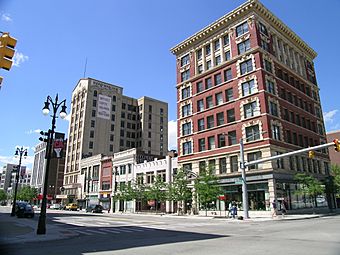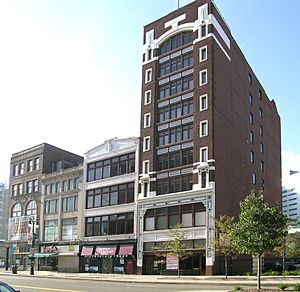Broadway Avenue Historic District (Detroit) facts for kids
Quick facts for kids |
|
|
Broadway Avenue Historic District
|
|

East side of Broadway
|
|
| Location | Detroit, Michigan, U.S. |
|---|---|
| Built | 1896 |
| Architect | Joseph E. Mills, et al. |
| Architectural style | Early Commercial Beaux-Arts |
| NRHP reference No. | 04000656 |
| Added to NRHP | July 1, 2004 |
The Broadway Avenue Historic District is a special block in downtown Detroit, Michigan. It's filled with old buildings that tell stories about the city's past. This area was recognized as important and added to the National Register of Historic Places in 2004. It's close to another historic spot, the Randolph Street Commercial Buildings Historic District, which has buildings from as far back as the 1840s!
What is the Broadway Avenue Historic District?
The Broadway Avenue Historic District has eleven commercial buildings. These buildings were built between 1896 and 1926. That means some of them are over 120 years old!
Three of these buildings are extra special. They are the Cary Building, the Breitmeyer–Tobin Building, and the Merchants Building. Each of these buildings is so important that they are also listed on the National Register of Historic Places on their own.
The buildings in the district often use a special type of decoration called terra cotta. This is a baked clay material that gives the buildings a similar look. The district is important because of its cool architecture, its history as a business area, and its connection to different cultures. It's also linked to Philip Breitmeyer, who was the mayor of Detroit from 1909 to 1911.
A Look at the District's History
The Broadway Avenue area started to grow in the late 1800s. It became a popular shopping spot, especially for women. You could find hairdressers, flower shops, and clothing stores there. Many of these shops were owned by people who had moved to Detroit from other countries.
In the 1910s, the area began to change. It slowly became a place for banks and financial businesses. A building nearby, at 1244 Randolph Street, is very old. It's one of the few buildings left from the 1840s in that area.
Later, in 1936, the Breitmeyer-Tobin Building on Broadway Avenue (now called Harmonie Centre) opened its doors to African-American businesses and tenants. In the 1950s, more shops owned by immigrants and different ethnic groups moved into the area. Some of these shops are still there today!
This part of downtown Detroit is sometimes called the Harmonie Park District. It has a strong connection to Detroit's music history. Many famous musicians and music businesses were active here from the 1930s through the 1950s, and this musical spirit continues today.
See also
 In Spanish: Distrito Histórico de Broadway Avenue para niños
In Spanish: Distrito Histórico de Broadway Avenue para niños
- Harvard Square Centre
- Harmonie Club
- Music of Detroit


